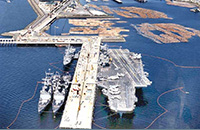Naval Station Everett
Naval Station Everett is the nation’s most modern naval facility and is located in Everett, Washington. Established in 1983, this facility is reported to be home to one nuclear-powered aircraft carrier, a Coast Guard buoy tender, three frigates and two destroyers.

Claims of injuries caused by asbestos have not been reported from Naval Station Everett. This might be because the station was built at a time when asbestos was used less often. It can take a long time for diseases from asbestos to show up, from 20 to 60 years.
Just because no claims were filed yet doesn’t mean there was no exposure to asbestos. Sometimes people are around it without knowing. Experts say we all breathe in a little bit of asbestos, but it usually doesn’t make us sick. Exposure to it could have occurred through damaged asbestos-containing materials.
Scientists looked at cancer caused by asbestos in naval workers. They published a study about it in 2021. Sailors from five Nordic countries were more than twice as likely to get mesothelioma.
In 2017, a report came out in the Archives of Environmental & Occupational Health. It looked at how likely shipyard workers are to get mesothelioma. Workers who were around a moderate amount of asbestos were four times more likely to die from this cancer. Some workers at Everett might have been around this much asbestos and could be at risk too.
Potential Asbestos Exposure at Naval Station Everett
Claims of injuries caused by asbestos have not been reported from Naval Station Everett. This might be because the station was built at a time when asbestos was used less often. It can take a long time for diseases from asbestos to show up, from 20 to 60 years.
Just because no claims were filed yet doesn’t mean there was no asbestos exposure. Sometimes people are around it without knowing. Experts say we all breathe in a little bit of asbestos, but it usually doesn’t make us sick.
In the past, there were problems with equipment safety at this station. The federal Department of Labor got complaints about the station’s safety a few times each quarter. These problems might have exposed people to asbestos without them knowing.
In 1970, the rules for using asbestos changed. The Navy made its own rules in 1975 to follow these new guidelines.
At first, the Navy’s rules were not strict enough. But they made better rules to manage asbestos and keep people safe. These rules applied to all Navy ships, boats, and facilities. Naval Station Everett was one of the first big places to be built with these safety rules.
But, in 1979, the Navy said that asbestos might not be too dangerous if it was used carefully. They believed asbestos could be used safely. They even gave an example of using asbestos safely, like in valve packing. But, they also said that removing asbestos was very important and could be risky.
Despite potential asbestos dangers, this naval station has done a lot for Everett, Washington, and for the whole country. It helps the local economy and keeps the nation safe with its naval defense.

Learn about your diagnosis, top doctors and how to pay for treatment.
Get Your Free GuideContributions by Naval Station Everett
The economics of the station’s contributions can hardly be overstated. The Navy spends nearly $72 million each year in the city of Everett and outlying Snohomish County communities. More than $245 million was spent on annual payroll for sailors and civilian workers, which are funds that will eventually spread throughout the local economy.
With the recent addition of the USS Nimitz, some expect the local economy to further benefit from increased staffing. The naval station is listed as the area’s second biggest employer. From a military perspective, the contribution of Naval Station Everett is also obvious.
This station is only one of six naval bases located on the West Coast and Japan that can have an aircraft carrier battle group. The Navy depends heavily upon this station and all others. According to one Commander, “Our defense will only be as strong as our maritime strength,” which reflects the importance of each station within the Navy, like Naval Station Everett.
Recommended Reading


